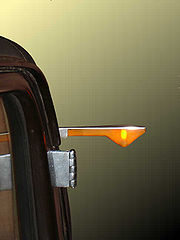
Trafficators
Encyclopedia


Motor vehicle
A motor vehicle or road vehicle is a self-propelled wheeled vehicle that does not operate on rails, such as trains or trolleys. The vehicle propulsion is provided by an engine or motor, usually by an internal combustion engine, or an electric motor, or some combination of the two, such as hybrid...
to indicate its intention to turn in the direction indicated by the pointing signal. Trafficators are often located at the door pillar.
History
They first appeared in the 1900s when they were actuated either mechanically or pneumatically. In 1908 Alfredo Barrachini in RomeRome
Rome is the capital of Italy and the country's largest and most populated city and comune, with over 2.7 million residents in . The city is located in the central-western portion of the Italian Peninsula, on the Tiber River within the Lazio region of Italy.Rome's history spans two and a half...
had added electric lights inside the arms that turned on as they extended but operation was still by a cable system. Electric operation came in 1918 when the Naillik Motor Signal Company of Boston
Boston
Boston is the capital of and largest city in Massachusetts, and is one of the oldest cities in the United States. The largest city in New England, Boston is regarded as the unofficial "Capital of New England" for its economic and cultural impact on the entire New England region. The city proper had...
added electric motor drive. This system was superseded by two French
France
The French Republic , The French Republic , The French Republic , (commonly known as France , is a unitary semi-presidential republic in Western Europe with several overseas territories and islands located on other continents and in the Indian, Pacific, and Atlantic oceans. Metropolitan France...
inventors, Gustave Deneef and Maurice Boisson, who used a linear solenoid
Solenoid
A solenoid is a coil wound into a tightly packed helix. In physics, the term solenoid refers to a long, thin loop of wire, often wrapped around a metallic core, which produces a magnetic field when an electric current is passed through it. Solenoids are important because they can create...
in 1923. The final complete system came in 1927 when Berlin
Berlin
Berlin is the capital city of Germany and is one of the 16 states of Germany. With a population of 3.45 million people, Berlin is Germany's largest city. It is the second most populous city proper and the seventh most populous urban area in the European Union...
-based Max Ruhl and Ernst Neuman combined internal illumination and solenoid operation.
The shape of the Trafficator arm is closely based upon the shape of the semaphore signal
Railway semaphore signal
One of the earliest forms of fixed railway signal is the semaphore. These signals display their different indications to train drivers by changing the angle of inclination of a pivoted 'arm'. Semaphore signals were patented in the early 1840s by Joseph James Stevens, and soon became the most...
arm used by the Royal Bavarian Railway beginning in 1890. The only difference from the railway arm is that it is halved down its length so as to fit flush with the vehicle's exterior.
They were common on vehicles until the introduction of the flashing amber or red indicators at or near the corners of the vehicle (and often along the sides as well). They have been increasingly rare since the 1950s, as ever-tightening legislation has prescribed the need for the modern type of flashing signal. Many historic vehicles that are used on today's roads have had their trafficators supplemented or replaced with modern indicators to aid visibility and to meet legislative requirements.
Turn indicator stalk
Turn indicator stalk or turn signal lever is the control lever which operates the turn signal or indicator lights on the front, sides and rear of the vehicle. It is usually operated by lifting or lowering the lever, the direction being commensurate with the clockwise or anticlockwise direction in which the steering wheel is about to be turned.In left hand drive vehicles the turn indicator stalks are located on the left of the steering column.
For most right-hand-drive (RHD) motor vehicle
Motor vehicle
A motor vehicle or road vehicle is a self-propelled wheeled vehicle that does not operate on rails, such as trains or trolleys. The vehicle propulsion is provided by an engine or motor, usually by an internal combustion engine, or an electric motor, or some combination of the two, such as hybrid...
s, the indicator stalk is also located on the left of the steering column, which is often the same component simply fitted to the other side of the vehicle. However, until the 1980s, British-made and Japanese-made right-hand-drive cars tended to have the stalk on the right-hand side. Whether for reasons of economy or ergonomics, this gradually phased out, first with British makes (with their close manufacturing ties to Europe) and eventually Japanese.
Some Japanese manufacturers such as Subaru still have variation in the model line up to where the turn indicator stalk is located.

